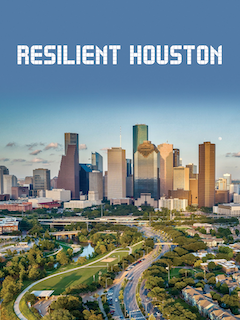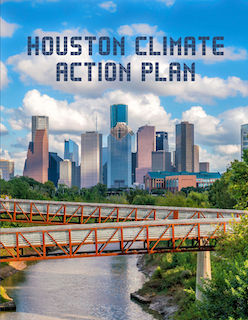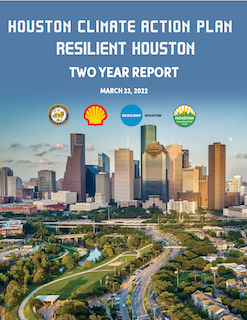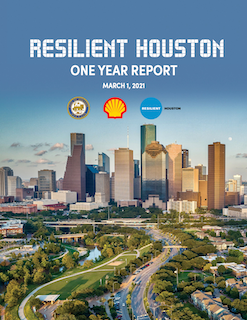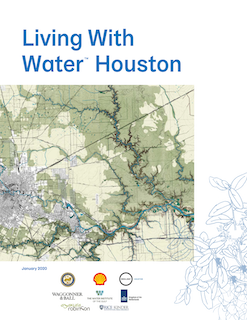Resilient Houston
Resilient Houston, the City of Houston’s resilience strategy, links existing efforts with new ones that will collectively work to protect Houston against future disasters—from hurricanes to extreme heat waves—and chronic stresses such as aging infrastructure, poor air quality, and flooding.
Resilient Houston sets 18 high-level targets across 5 scales. The following section shows the city’s progress in 2021 on each of the targets. Click on a target to read more information.
PREPARED & THRIVING HOUSTONIANS
Making Houston more resilient begins with supporting Houstonians with tools and resources to be resilient as individuals. Our collective resilience improves when all Houstonians have the capacity to prepare for and adapt to an increasingly uncertain future, have access to employment and wealth-building opportunities, and enjoy a safe and healthy quality of life.
Target 1 — Provide at least 500,000 Houstonians with preparedness training by 2025
2022 Activity — 65,897 interactions (i.e. training, presentations, educational materials, etc.)
Ongoing
Target 2 — Offer 20,000 Hire Houston Youth Summer Jobs in 2020
2022 Activity — 14,018 jobs provided through Hire Houston Youth
Ongoing
Target 3 — Ensure zero traffic-related fatalities and serious injuries on Houston streets by 2030
2022 Activity — 331 fatalities, 1,619 serious injuries
Ongoing, but trending away from target
SAFE & EQUITABLE NEIGHBORHOODS
Each of Houston’s 88 super neighborhoods has different resilience priorities, including flooding, air quality, displacement, and mobility. These challenges are best addressed by developing and implementing place-based solutions at the neighborhood scale.
Target 4 — Develop 50 neighborhood plans by 2030
2022 Activity — 3 neighborhood plans developed (Independence Heights, East Houston, and Edgebrook Area)
Ongoing
Target 5 — Invest $5 million in local artists to create resilience awareness projects across the city by 2025
2022 Activity — $225,000 awarded as additional grants
Complete
Target 6 — Plant 4.6 million new native trees by 2030
2022 Activity — 214,134 trees planted
Ongoing
HEALTHY & CONNECTED BAYOUS
Living safely with water and embracing the role of bayous as Houston’s front yard are essential to improving physical, environmental, and economic resilience.
Target 7 — Build at least 375,000 new homes across every income level by 2050 to welcome new residents to the City of Houston
2022 Activity — 18,214 units built
Ongoing
Target 8 — Remove all habitable structures from the floodway by 2030
2021 Activity — 81 structures removed from the floodway
Ongoing
Target 9 — Construct at least 500 miles of trails and bike lanes by 2025
2022 Activity — 20miles of high-comfort bike facilities built
Ongoing
ACCESSIBLE & ADAPTIVE CITY
The City of Houston will lead by example to further embed climate readiness, equity, inclusion and resilience into all City policies and practices.
Target 10 — Achieve carbon neutrality by 2050 in accordance with the Paris Agreement
2022 Activity — 30,050,613 metric tonnes CO2e in 2020
Ongoing
Target 11 — Complete 100 new green stormwater infrastructure projects by 2025
2022 Activity — 16 green stormwater infrastructure projects
Ongoing
Target 12 — Eliminate geographic disparities in life expectancy by 2050
2022 Activity — No update
Ongoing - no updated life expectancy figures released for Harris County
INNOVATIVE & INTEGRATED REGION
By taking a regional approach to building resilience, we can extend the benefits of resilience planning to more communities while including additional partners who increase our capacity to meet these goals.
Target 13 — Appoint resilience officers in every City of Houston department in 2020
2022 Activity — No changes
Complete
Target 14 — Attract or incubate 50 Energy 2.0 companies in Greater Houston by 2025
2022 Activity — 75 Houston-based members of Greentown Labs
Complete
Target 15 — Provide 100% of Houstonians access to high-frequency public transportation choices within a half-mile by 2050
2022 Activity — 49% of Houstonians now have access
Ongoing
Target 16 — Conserve 24% of undeveloped regional lands as natural spaces by 2040
2022 Activity — 15.6% of undeveloped regional lands preserved
Ongoing
Target 17 — Ensure that 100% of Houstonians and visitors have access to accurate, real-time emergency alerting by 2030
2022 Activity — 10% of Houstonians (22,266) are registered in Alert Houston
Ongoing
Target 18 — Invest $50 billion in major recovery, mitigation, and modernization projects that increase resilience by 2040
2021 Activity — $7,757,461,894 invested
Ongoing
Climate Action Plan
A Climate Action Plan provides evidenced-based measures to reduce greenhouse gas emissions and preventative measures to address the negative outcomes of climate change. Houston’s Climate Action Plan will demonstrate how the City will adapt and improve its resilience to climate hazards that impact the city today as well as risks that may increase in the coming years. The CAP was developed as a companion document to Resilient Houston.
The plan is organized into four focus areas: Transportation, Energy Transition, Building Optimization, and Materials Management.
TRANSPORTATION
Target 1 — Convert non-emergency, light-duty municipal fleet to 100% EV by 2030
2022 Activity — 14% of the city's municipal fleet are electric vehicles (EVs)
Ongoing
Target 2 — Reduce Vehicle Miles Traveled (VMT) per capita 20% by 2050
2022 Activity — 16,012 per capita vehicle miles traveled (VMT)
Ongoing
Target 3 — Ensure zero traffic-related fatalities and serious injuries on Houston streets by 2030
2022 Activity — 331 fatalities, 1,619 serious injuries
Ongoing, but trending away from target
ENERGY TRANSITION
Target 4 — 5 million MWh local solar per year by 2050
2021 Activity — 148,030 MWh solar produced
Ongoing
Target 5 — Attract or incubate 50 Energy 2.0 companies in Greater Houston by 2025
2022 Activity — 75 Houston-based members of Greentown Labs
Complete
Target 6 — Plant 4.6 million new native trees by 2030
2022 Activity — 214,134 trees planted
Ongoing
BUILDING OPTIMIZATION
Target 7 — Adopt the 2021 ICC model building code by 2025
2022 Activity — 2015 ICC model building code was adopted in 2021, along with 2020 Energy code
Ongoing
Target 8 — Double the current number of Property Assessed Clean Energy (PACE) projects by 2025
Complete
Target 9 — 70% of non-residential buildings operated by trained building operator by 2030
2022 Activity — 3 operators trained
Ongoing
MATERIALS MANAGEMENT
Target 10 — Reduce residential waste 50% by 2040
2022 Activity — 737,406 tons of residential waste collected
Ongoing
Target 11 — Convert municipal solid waste fleet to low-emission vehicles by 2030
2022 Activity — 3.5% of the municipal waste solid waste fleet are low emissions vehicles
Ongoing
Climate and Resilience Publications

